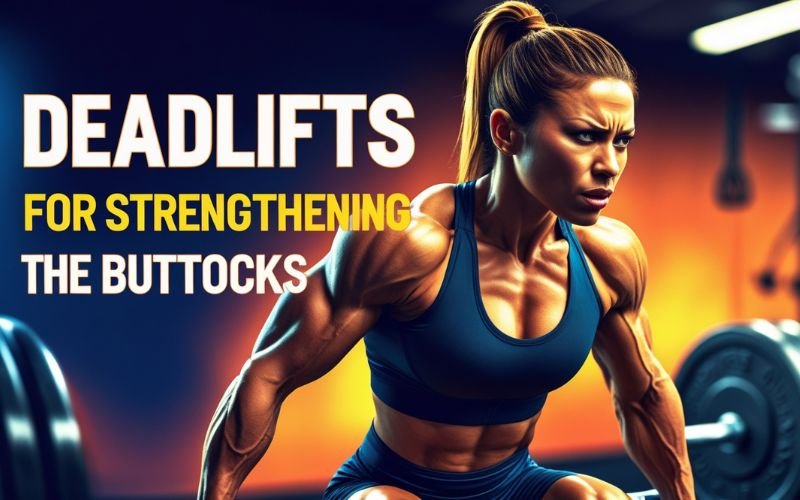Deadlifts for Strengthening the Buttocks
Introduction
Few exercises can rival the sheer power of deadlifts when it comes to sculpting and strengthening the buttocks. This powerhouse movement doesn’t just build brute strength—it shapes and lifts the glutes like no other. Unlike isolated glute exercises, deadlifts recruit multiple muscle groups, forcing the glutes to work in harmony with the hamstrings, lower back, and core.
The beauty of deadlifts lies in their ability to mimic real-life movements. Every time you pick something off the floor, your body performs a variation of a deadlift. When done correctly, this exercise not only enhances glute strength but also improves posture, balance, and overall athleticism.
How Deadlifts Target the Buttocks Muscles
The gluteus maximus—the largest and most powerful muscle in the body—is the primary driver of the deadlift. As you hinge at the hips and lift the barbell, your glutes fire up to extend the hips and bring your body to an upright position. This explosive movement is what builds that firm, rounded shape many people strive for.
The gluteus medius and minimus also play a supporting role, stabilizing the hips and preventing unwanted wobbling. Meanwhile, the hamstrings and lower back contribute to the lifting motion, making the deadlift a full posterior-chain exercise.
Best Deadlift Variations for Maximum Glute Activation
Not all deadlifts are created equal. While the conventional deadlift is a fantastic overall strength builder, certain variations place even greater emphasis on the glutes.
- Sumo Deadlift – A wider stance means more hip engagement, making this an excellent choice for targeting the glutes.
- Romanian Deadlift (RDL) – A controlled, hip-dominant movement that stretches the glutes and hamstrings while keeping tension throughout the lift.
- Trap Bar Deadlift – A more knee-friendly variation that still allows for powerful glute activation.
- Single-Leg Deadlift – Engages stabilizing muscles while honing in on each glute individually for better muscle symmetry.
- Deficit Deadlift – Elevating the feet increases the range of motion, forcing the glutes to work harder through an extended stretch.
Choosing the right variation depends on your goals, flexibility, and overall training experience.
Common Mistakes That Reduce Glute Engagement
Even with the best intentions, many lifters fail to maximize glute activation due to poor technique. Here are some of the most common pitfalls:
- Relying Too Much on the Lower Back – Overarching the back shifts the workload away from the glutes and onto the spine, increasing injury risk.
- Not Fully Locking Out at the Top – Failing to squeeze the glutes at the top of the movement leaves gains on the table.
- Using Too Much Knee Drive – Deadlifts are a hip-hinge movement, not a squat. Overuse of the quads diminishes glute activation.
- Starting Too Heavy – Going too heavy too soon often leads to poor form, reducing the effectiveness of the exercise.
Small tweaks can make a significant difference. Practicing proper hip engagement and ensuring full extension at the top will transform the way deadlifts shape the glutes.
Tips for Getting the Most Out of Your Deadlift Workouts
To truly maximize glute development, proper execution is key. Here are some actionable tips:
- Warm Up the Glutes First – Activating the glutes with banded exercises or bodyweight movements ensures they fire efficiently during deadlifts.
- Focus on Hip Drive – Think about pushing the floor away rather than pulling the bar up. This mental cue enhances glute activation.
- Control the Eccentric Phase – Lowering the weight slowly increases time under tension, which is crucial for muscle growth.
- Keep the Bar Close to the Body – This reduces unnecessary strain on the lower back and keeps the movement glute-dominant.
- Mix Up Rep Ranges – Heavy sets build strength, while moderate-to-high reps (8-12) are great for hypertrophy and muscle shaping.
By fine-tuning your technique, deadlifts can become the ultimate weapon in your glute-training arsenal.
How Often Should You Do Deadlifts for Stronger Glutes?
The frequency of deadlift training depends on recovery, experience level, and overall workout structure. Here’s a general guideline:
- Beginners – 1-2 times per week with a focus on form and technique.
- Intermediate Lifters – 2-3 times per week, incorporating different variations.
- Advanced Lifters – 3 times per week, with an emphasis on progressive overload and intensity.
Because deadlifts are demanding, adequate rest is essential. Overtraining can lead to fatigue, compromised form, and reduced muscle growth. Listen to your body and adjust accordingly.
Complementary Exercises to Enhance Your Results
While deadlifts are phenomenal for glute growth, pairing them with complementary exercises will yield even better results. Consider adding these movements:
- Hip Thrusts – Arguably the best isolation movement for maximum glute activation.
- Bulgarian Split Squats – Great for unilateral glute strength and balance.
- Glute Bridges – A simpler variation of hip thrusts, ideal for activation before deadlifts.
- Step-Ups – Excellent for building functional strength and endurance in the glutes.
- Cable Kickbacks – Helps to fine-tune and shape the glute muscles with controlled resistance.
By combining deadlifts with targeted glute exercises, you create a well-rounded lower-body routine that guarantees strength, power, and aesthetics.
Best Supplements to Boost Glute Growth from Deadlifts
Fueling your body with the right supplements can enhance muscle growth, recovery, and strength for better glute development.
- Protein powder supports muscle repair, ensuring your glutes recover and grow stronger after intense deadlifts.
- Creatine boosts power and endurance, helping you lift heavier and maximize glute activation.
- BCAAs reduce muscle soreness, while omega-3s fight inflammation.
A balanced diet plus smart supplementation will optimize your results.
Final Thoughts
Deadlifts are more than just a strength exercise—they are a glute-building powerhouse. By incorporating proper form, strategic variations, and complementary exercises, you can sculpt stronger, more defined buttocks. Train smart, stay consistent, and watch your glutes transform with every lift.









Add comment
You must be logged in to post a comment.